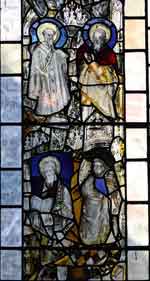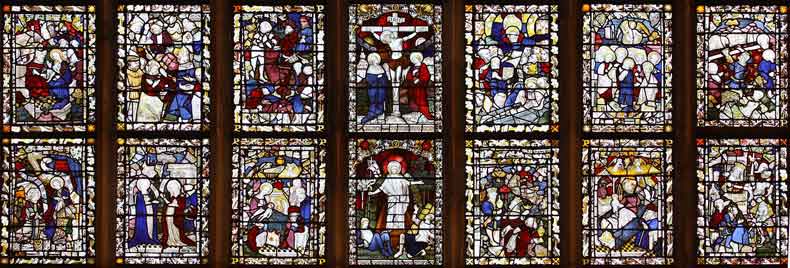15th Century Glass Makers
Medieval Norfolk was rich. Money speaks, and in this case it spoke 'religion'. Thus wealth translated itself into religious foundations and splendid churches. Norwich, with its cathedral, was the central focus of the economic, religious, political and social life of the county. It also became the home of great artistic activity from the end of the 12th century though to the Reformation. As churches were enlarged and enriched demands on local craftsmen grew.
 Glass painters were only one of a group of artisans who were embellishing churches at the time. Churches were highly decorated and contained painted and highly-decorated walls, screens and panels. Although much of this early work has been lost maybe we should count ourselves lucky that so much survives.
Glass painters were only one of a group of artisans who were embellishing churches at the time. Churches were highly decorated and contained painted and highly-decorated walls, screens and panels. Although much of this early work has been lost maybe we should count ourselves lucky that so much survives.
Work produced by the artisans from the Norwich School had the following characteristics:
- An excellence of drawing and colouring coupled with a lively presentation of the subject matter.
- Use of particular decorative motifs and stylised renditions of landscapes and floors, including
- Ears of Barley: Thus called because the design resembles ears of barley lain in rows, although it probably derived from an attempt to depict the grain in wood. Examples can be seen in a variety of churches including Saxlingham Nethergate and Salle.
- Seaweed Pattern: This originated in the 14th century and appears either as a tightly curled form (Saxlingham Nethergate) but is often of looser appearance (Salle). Again it is found in a number of churches including St Peter Mancroft (east window: Adoration of the Magi panel) and East Harling (east window: Sir Robert Wingfield panel).
- Chequered Paving: This is a very common motif in English art first occurring in Norfolk glass at Great Cressingham. It is found in churches across the region including: St Peter Mancroft (east window : some of Toppes windows) and Salle.
- Pebbled Floors: As found at Great Cressingham.
- Clifflets, i.e. Terraced Hillocks (often decorated with tufts of grass): These can be seen at Saxlingham Nethergate, St Peter Mancroft (adoration of the Magi) and North Tuddenham (with the figure of Moses).
- Trees and Flowers (often depicted in stylised form): These can be found at East Tuddenham in the west window and in the tracery light panels at Great Cressingham.
- In common with wood carvers and painters, the glass painters used a border of varying size which had a foliage design resembling a holly leaf wrapped around a rod. Yyellow stain was often used to colour the rod, whilst the foliage and background remained white.
- Unlike their contemporaries:
- They did not favour large and ornate crowns.
- They did not overload the garments of the saints with colour and ornament (see St James in St Peter Hungate’s east window).
- They let white glass play a large part in their colour schemes and made use of fur to give variety to it.
On this site we feature 15th-century stained glass from across the county, including the internationally important east window in St Peter Mancroft (Norwich ). The 'Zoom' facility enables the exquisite features that characterise this period to be seen enabling all to assess Christopher Woodforde’s theory that Norwich’s 15th-century craftsmen: 'Avoided the suggestions of sweetness and sentimentality which mars some contemporary work...there is a bracing strength and vigour which well accords with the Norfolk climate and character' (p170). That said it is also important to see the glass in situ...but don’t forget your binoculars.
For further information refer to Christopher Woodfordes’: ' Norwich 15th Century School of Glass Painting' and David King’s 'The Medieval Stained Glass of St Peter Mancroft'. See the Bibliography for full details.
